How to Grow Peonies
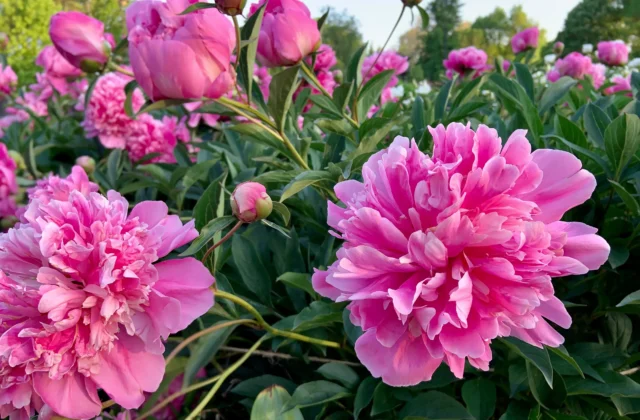
Introduction
Peonies, belong to the genus Paeonia. Gardeners and flower enthusiasts love their luxurious blooms and intoxicating fragrance. Understanding the basics of how to grow peonies is essential for any aspiring gardener. Peonies have been an important part of many cultures for centuries. In Chinese tradition, they symbolize prosperity and honor. In Europe, they were loved by nobility and aristocracy. Growing peonies starts with selecting the right plant.
Understanding how to grow peonies begins with selecting the ideal planting location. These resilient perennials thrive in well-draining soil and prefer a sunny spot. Once planted, mastering how to grow peonies involves providing consistent care and attention throughout the growing season. Consider space when choosing peony varieties for your garden.
Selecting the Perfect Peony Varieties
For eye-catching garden beds, mix peonies in pink, white, yellow, and red hues. It’s also important to familiarize yourself with different peony varieties with unique characteristics and specific growing conditions. How to grow peonies begins with selecting a suitable planting location. Understanding flower form variations like single, semi-double, double, anemone-centered, and Japanese will guide you in creating a beautiful peony paradise.
Understanding Peony Varieties
When embarking on your peony paradise journey, it’s crucial to familiarize yourself with the diverse types of peonies available. Whether it’s the herbaceous, tree, or intersectional hybrids, each variety boasts unique characteristics and requires specific growing conditions. Understanding flower form variations like single, semi-double, double, anemone-centered, and Japanese guides garden design. Appreciating diverse foliage textures, colors, and fragrances enhances peony paradise. Understanding how to grow peonies involves choosing the right peony variety for your climate.
Varieties of Peonies
Before we delve into how to grow peonies it is essential to learn about its varieties. Peonies come in many types, each with a unique charm. From herbaceous to tree and intersectional hybrids, knowing the different types can expand the horizons for flower enthusiasts.
Herbaceous Peonies
These are the most common and widely cultivated peonies, known for their lush foliage and showy flowers. Herbaceous peonies go dormant in winter, resurfacing in spring with varied colorful blooms. With proper care and maintenance, herbaceous peonies can thrive for decades, rewarding gardeners with abundant blooms each spring.
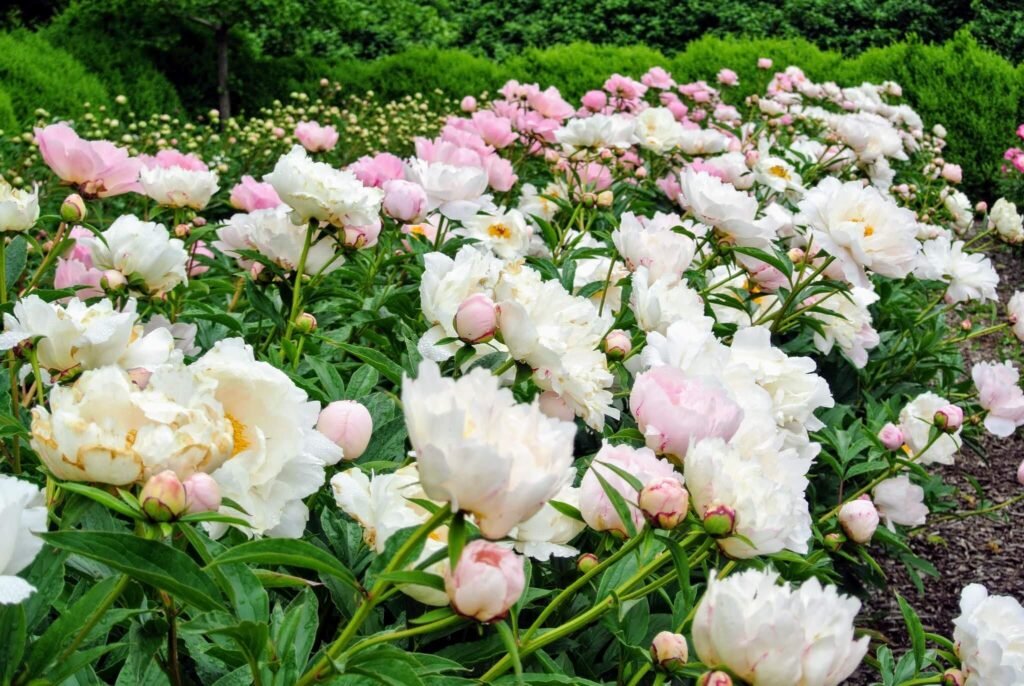
They are categorized into several types based on flower form and growth habits. Here are the main types of herbaceous peonies:
Single-flowered Herbaceous Peonies
These peonies feature a single row of petals surrounding a prominent center of stamens. Single-flowered varieties often have a simple yet elegant appearance, with petals that may be flat or slightly cupped. Examples include ‘Sarah Bernhardt’, and ‘Early Scout’.
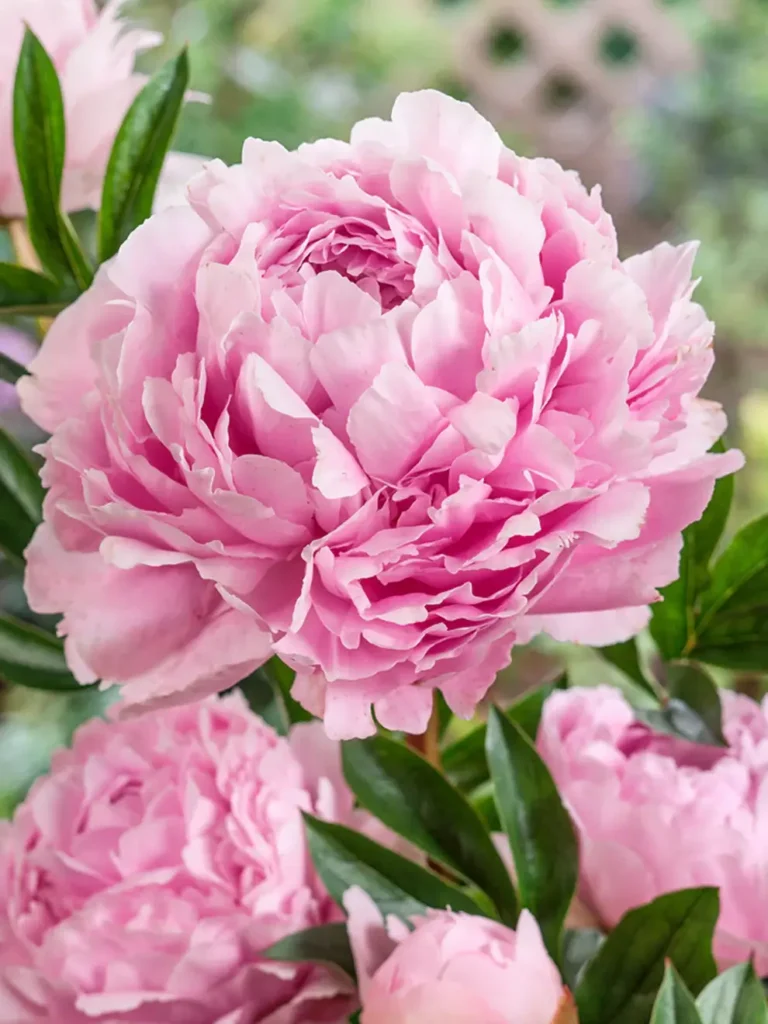
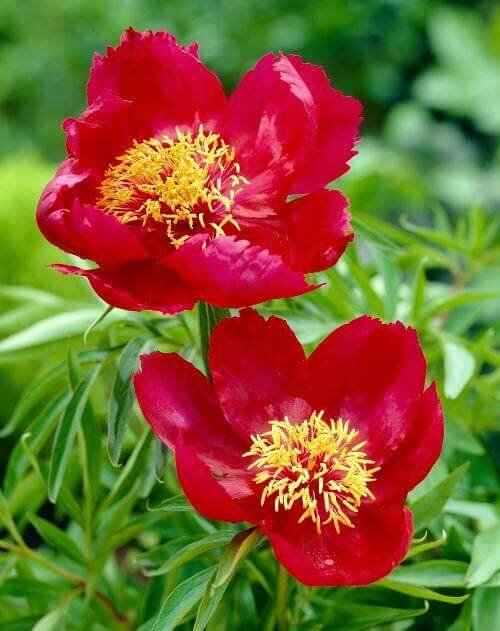
Double-Flowered Herbaceous Peonies
They are prized for their densely packed petals, creating a lush, voluminous bloom. These peonies may have multiple layers of petals, giving them a luxurious and opulent appearance. Varieties such as ‘Bowl of Beauty’, ‘Festiva Maxima’, and ‘Duchesse de Nemours’ are popular examples of double-flowered herbaceous peonies.
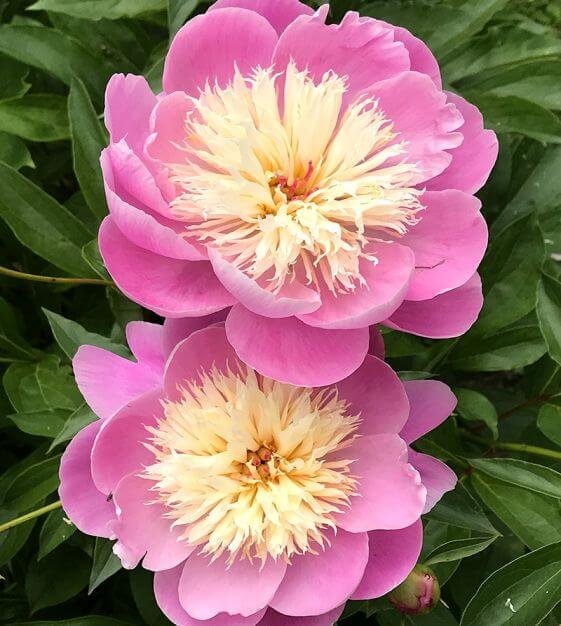
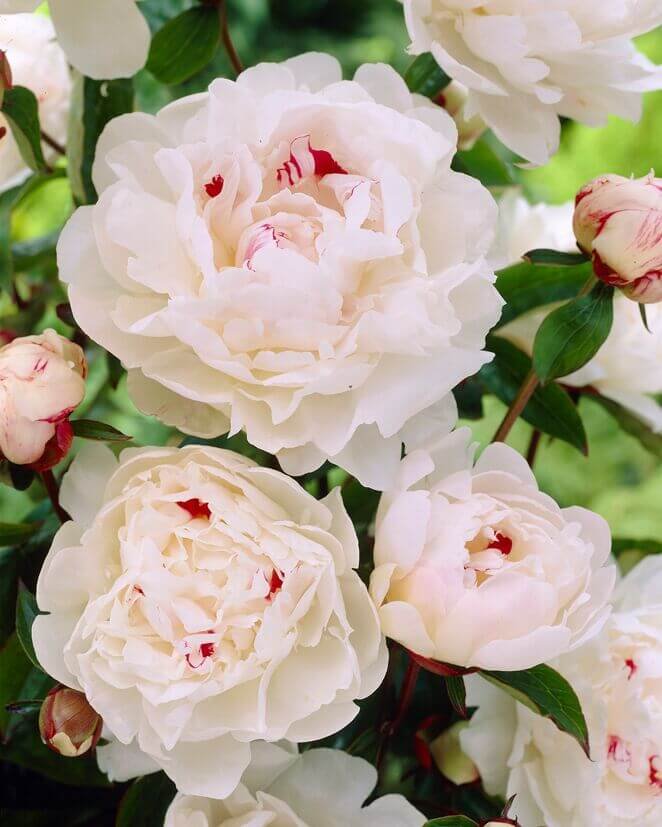
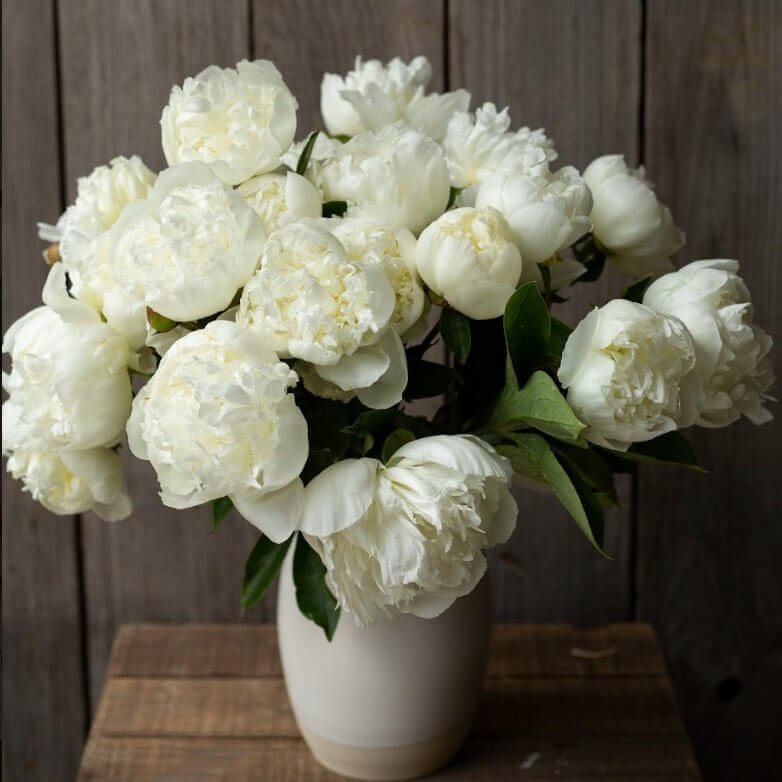
Semi-double Flowered Herbaceous Peonies
Semi-double herbaceous peonies strike a balance between single and double-flowered varieties, featuring a combination of petals and stamens. These peonies offer a more intricate bloom form than singles but are not as densely packed as doubles. Varieties like ‘Coral Sunset’ and ‘Kansas’ showcase the beauty of semi-double flowered herbaceous peonies.
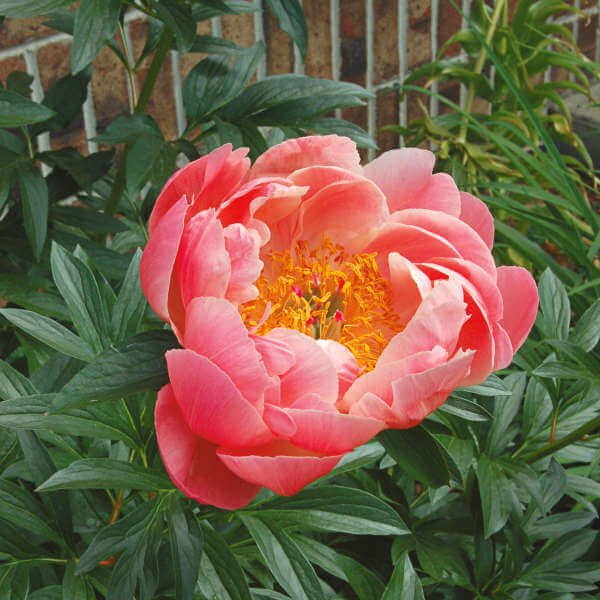
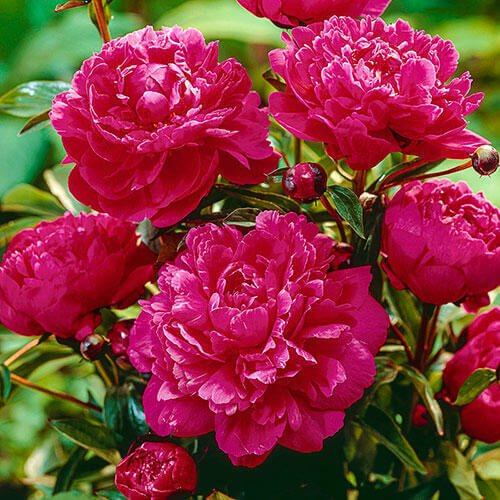
Anemone Flowered Herbaceous Peonies
Anemone peonies have petaloid stamens in the center and outer petals around them. These peonies have a distinctive appearance reminiscent of anemone flowers, with a central boss of contrasting stamens. Varieties such as ‘Do Tell’, ‘Gay Paree’, and ‘Cora Stubbs’ exhibit the unique charm of anemone-flowered herbaceous peonies.
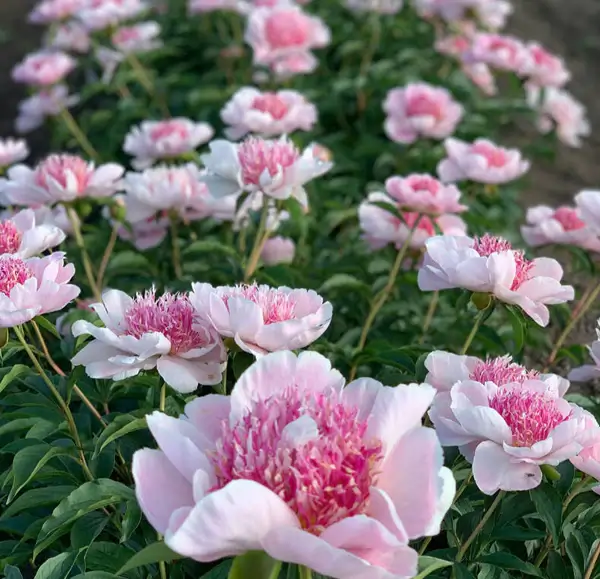
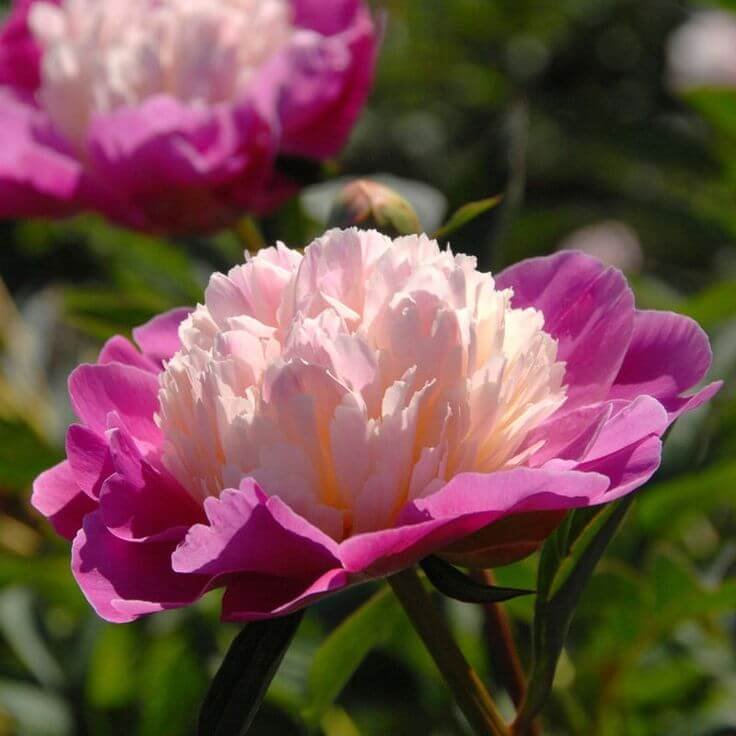
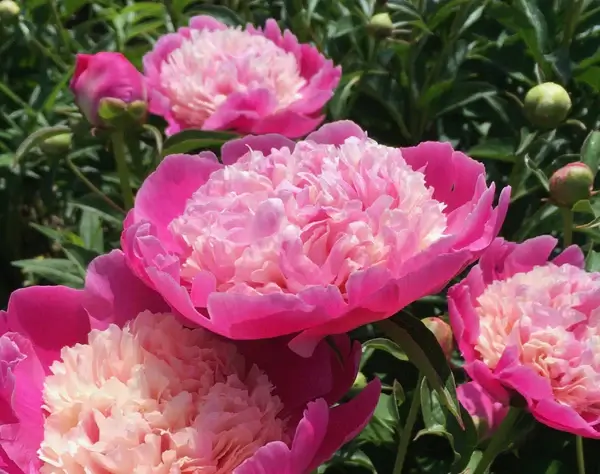
Japanese Flowered Herbaceous Peonies
Japanese-flowered herbaceous peonies feature a center of petaloid stamens surrounded by one or more rows of broad, flat petals. The central stamens may be of a contrasting color, creating a striking contrast with the surrounding petals. Varieties like ‘Red Charm’, and ‘Monsieur Jules Elie’ exemplify the beauty of Japanese-flowered herbaceous peonies.
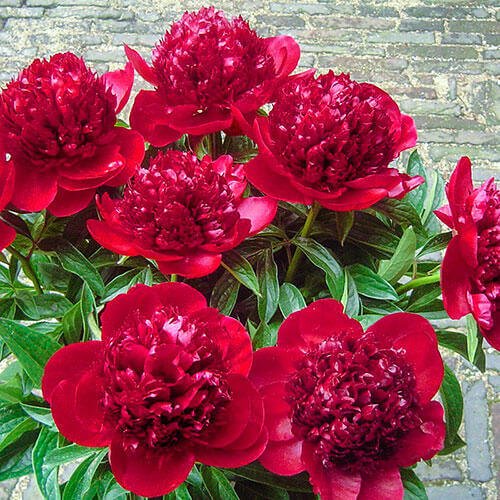
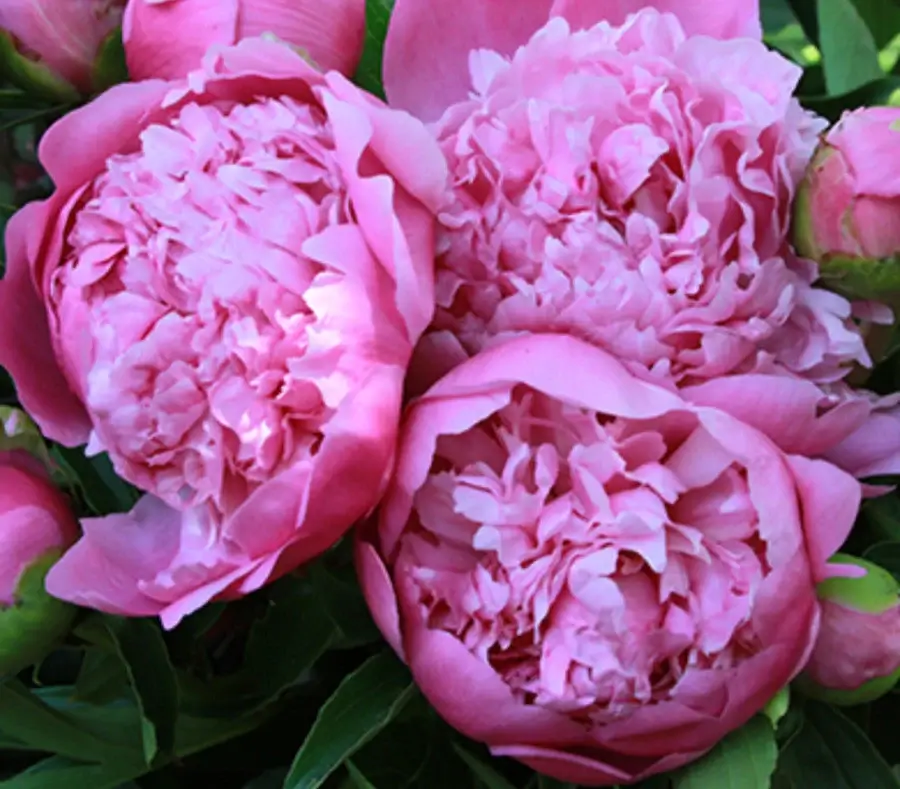
Tree Peonies
They are native to China, and are woody shrubs prized for their large, often fragrant flowers and ornamental foliage. Tree peonies have woody stems year-round, adding structure to the garden even when not in bloom. Tree peonies come in an array of colors and flower forms, ranging from delicate pastels to bold, saturated hues.
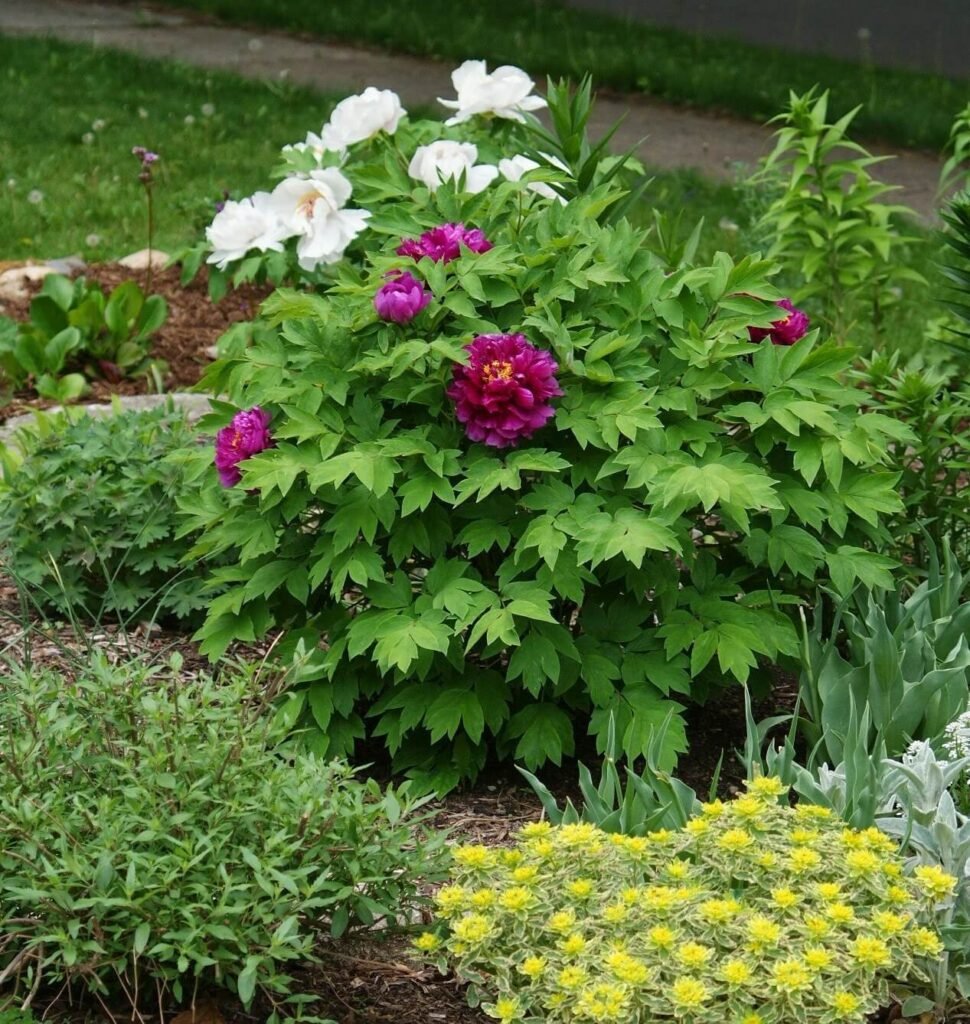
Here are the main types of tree peonies:
Single-flowered Tree Peonies
Single-flowered tree peonies feature blooms with a single row of petals surrounding a prominent center of stamens. These peonies often have large, striking flowers with a simple yet elegant appearance. Examples include ‘Rockii’, ‘High Noon’, and ‘Shima-Nishiki’.
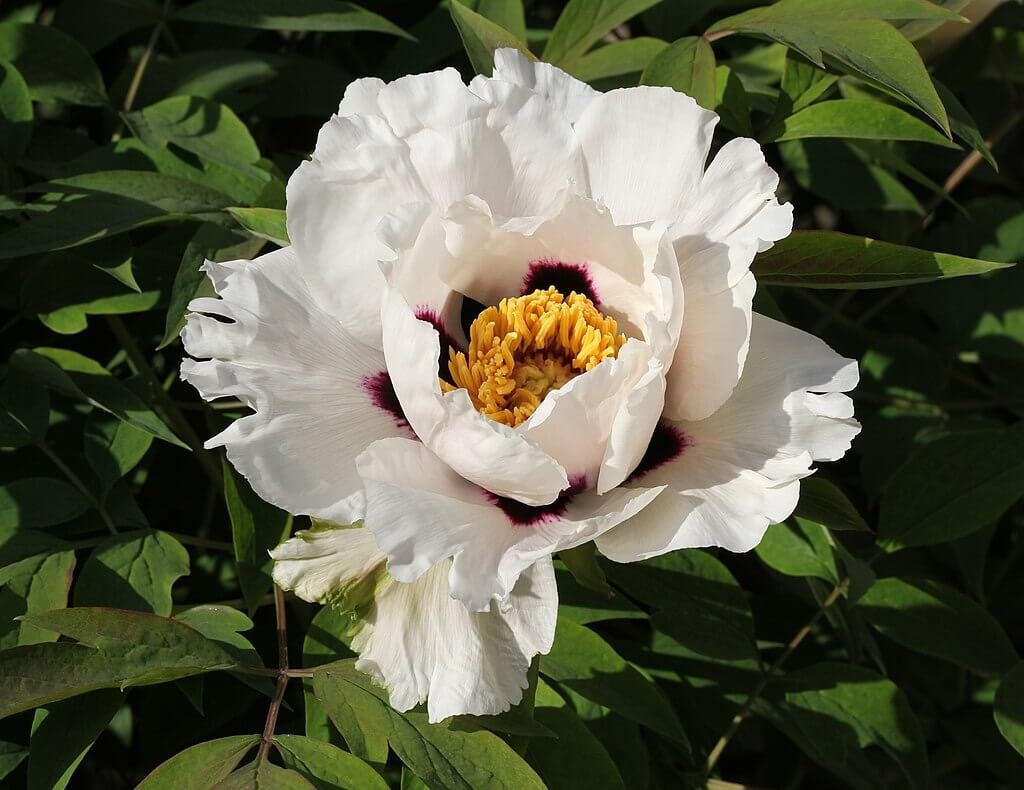
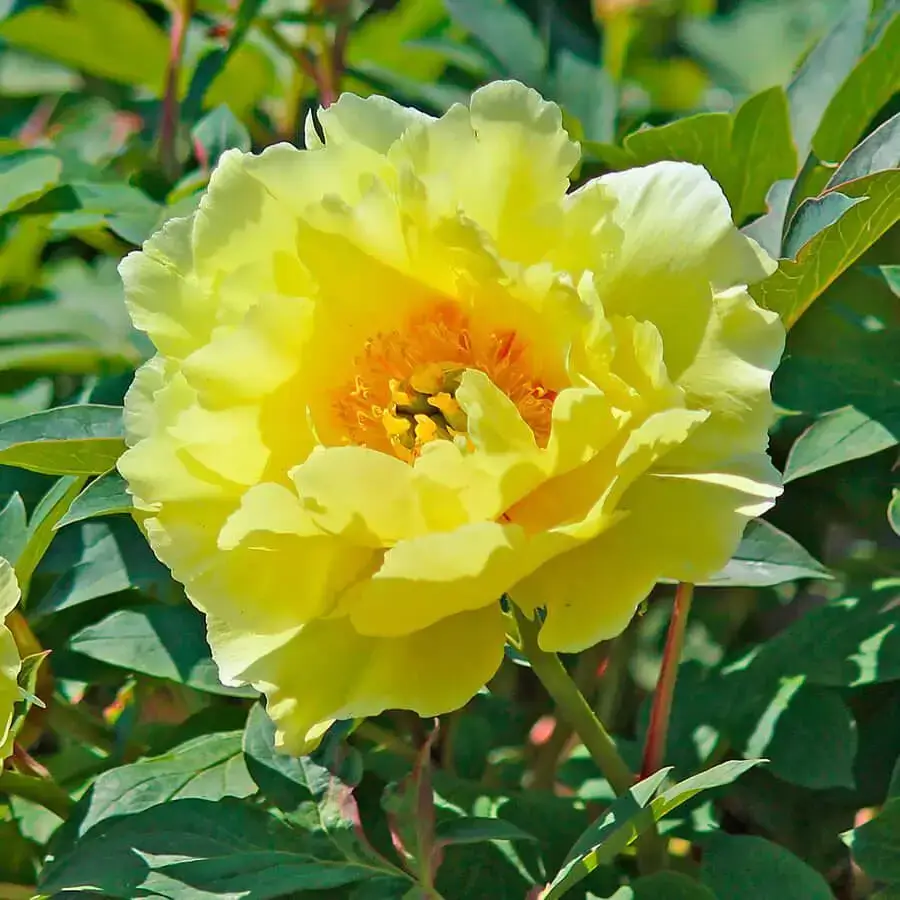
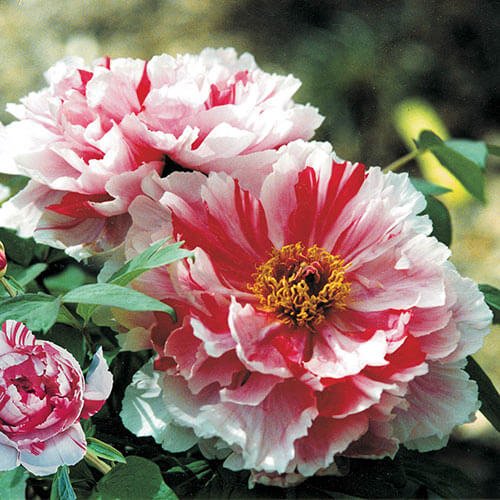
Double-flowered Tree Peonies
Double-flowered tree peonies are prized for their densely packed petals, creating a lush and opulent bloom. These peonies may have multiple layers of petals, giving them a lavish and voluminous appearance. Varieties such as ‘Renkaku’, ‘Kamada Nishiki’, and ‘Golden Era’ showcase the beauty of double-flowered tree peonies.
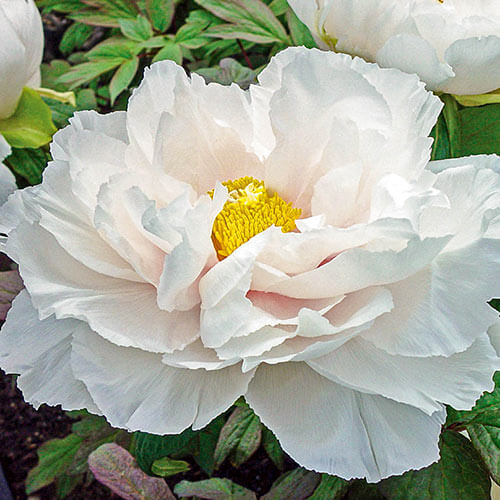
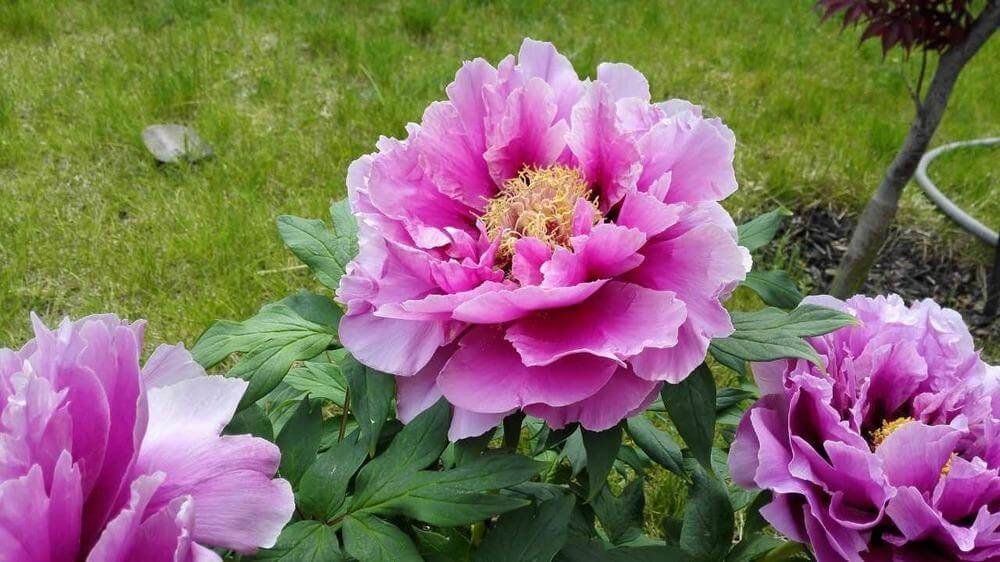
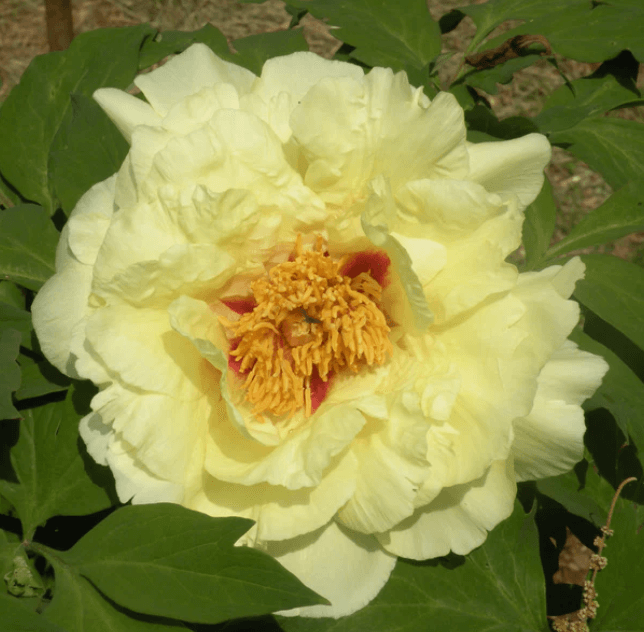
Semi-double-flowered Tree Peonies
Semi-double-flowered tree peonies feature a combination of petals and stamens, offering a more intricate bloom form than singles. These peonies strike a balance between the simplicity of single-flowered varieties and the lushness of doubles. Varieties like ‘Age of Gold’, ‘Blue Sapphire’, and ‘Destiny’ exemplify the charm of semi-double-flowered tree peonies.
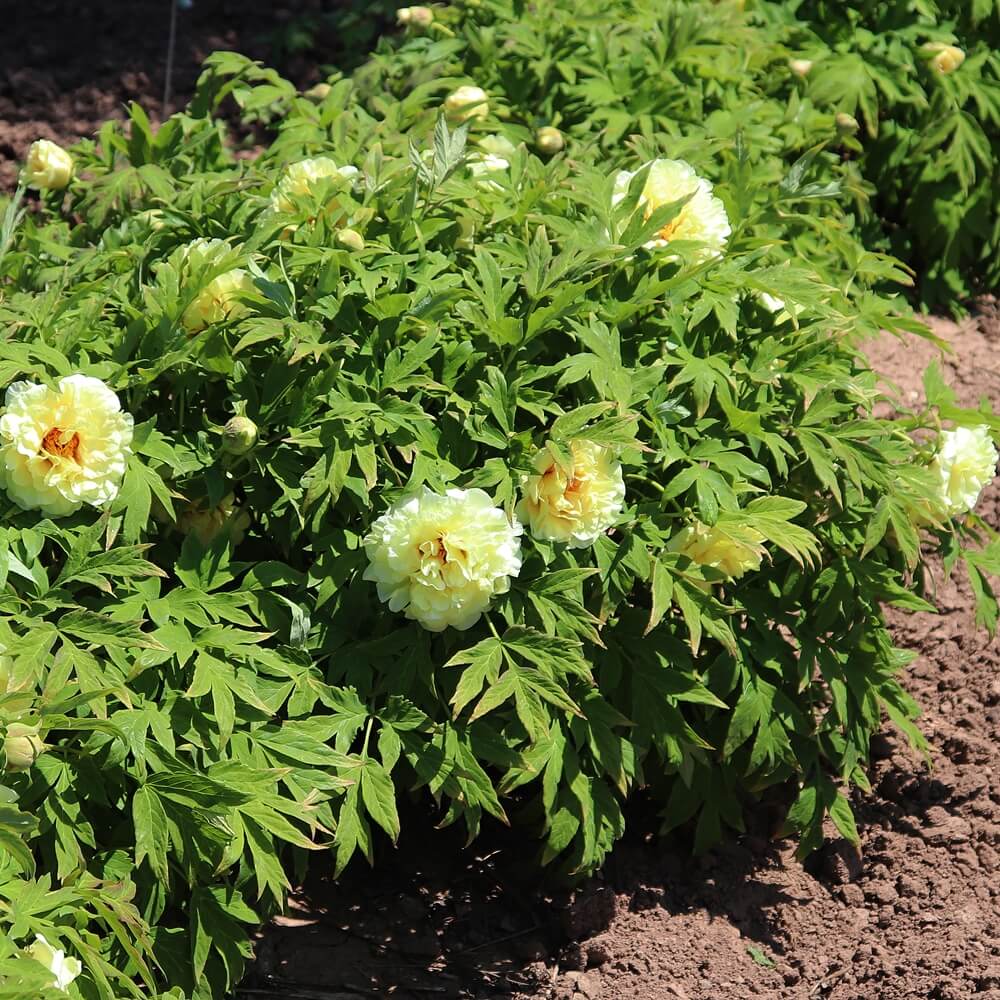
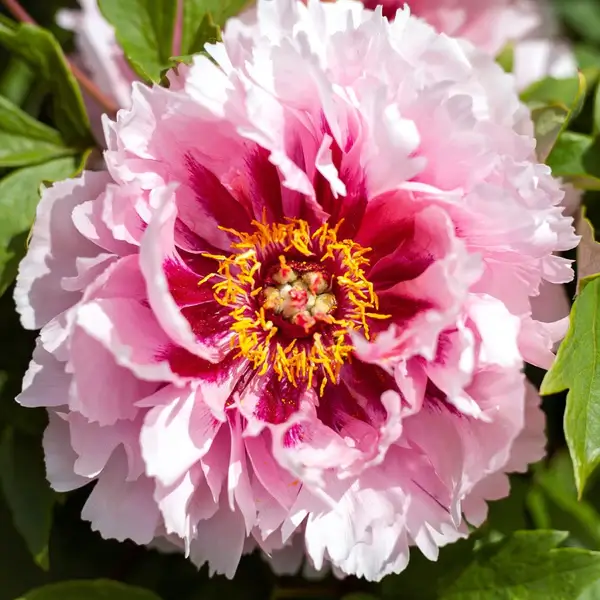
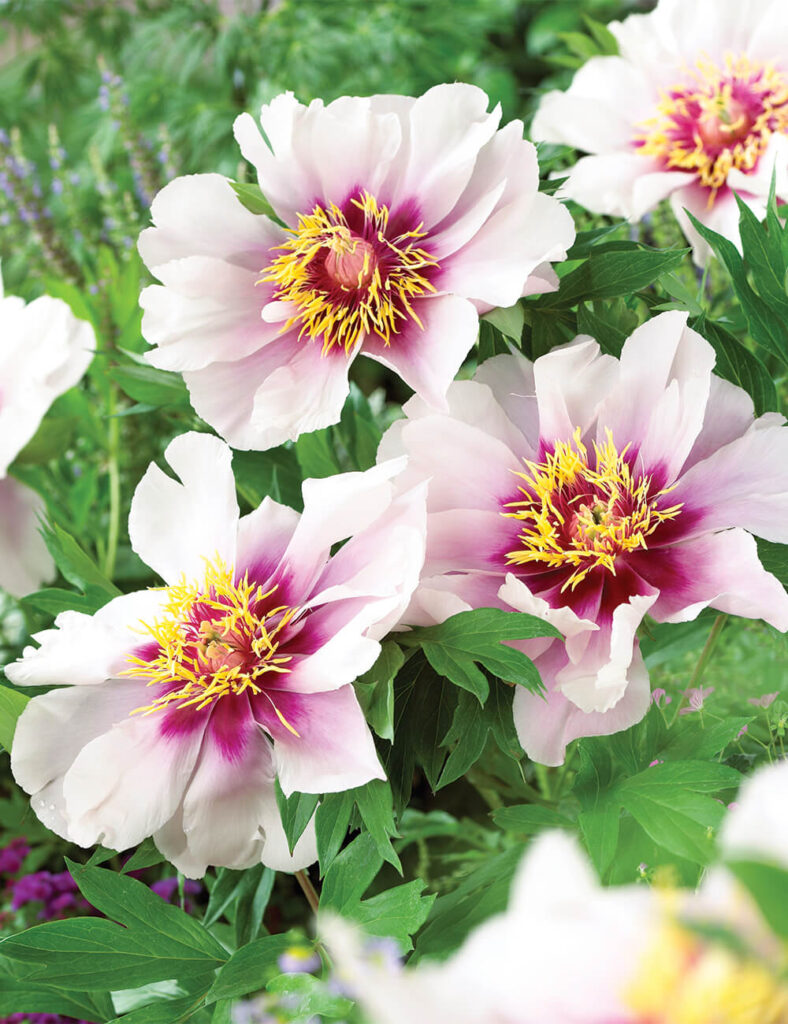
Japanese-flowered Tree Peonies
Japanese-flowered tree peonies feature a center of petaloid stamens surrounded by one or more rows of broad, flat petals. The central stamens may be of a contrasting color, creating a striking contrast with the surrounding petals. Varieties such as ‘Kinkaku’ showcase the beauty of Japanese-flowered tree peonies.
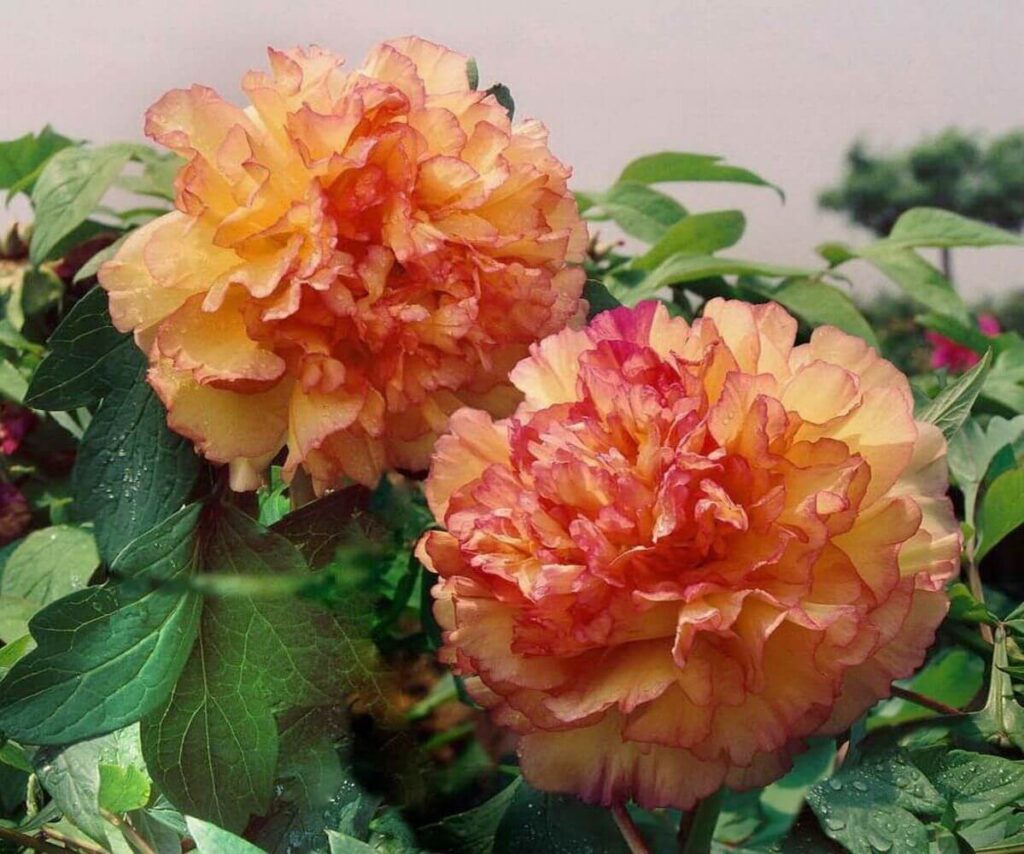
Hybrid Tree Peonies
Hybrid tree peonies are crosses between different species or varieties, resulting in a wide range of colors, forms, and characteristics. These peonies often exhibit unique traits and may incorporate traits from both parents. Examples include ‘Boreas’, ‘First Arrival’, and ‘Chiffon Clouds’.
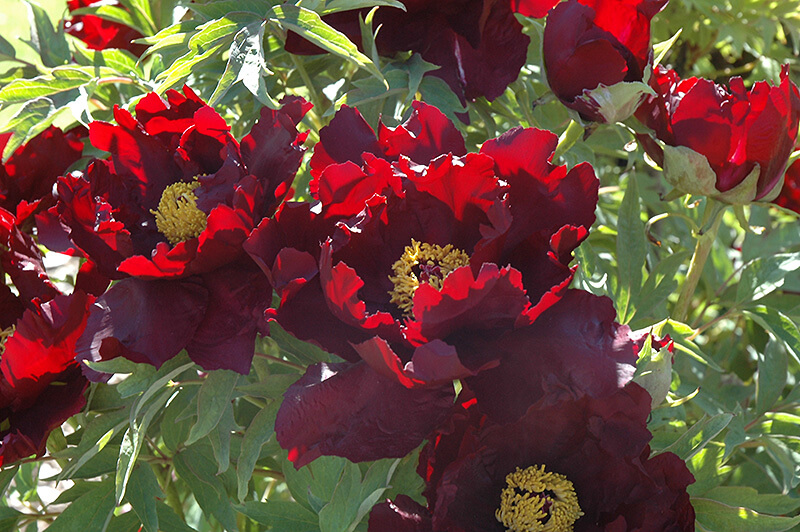
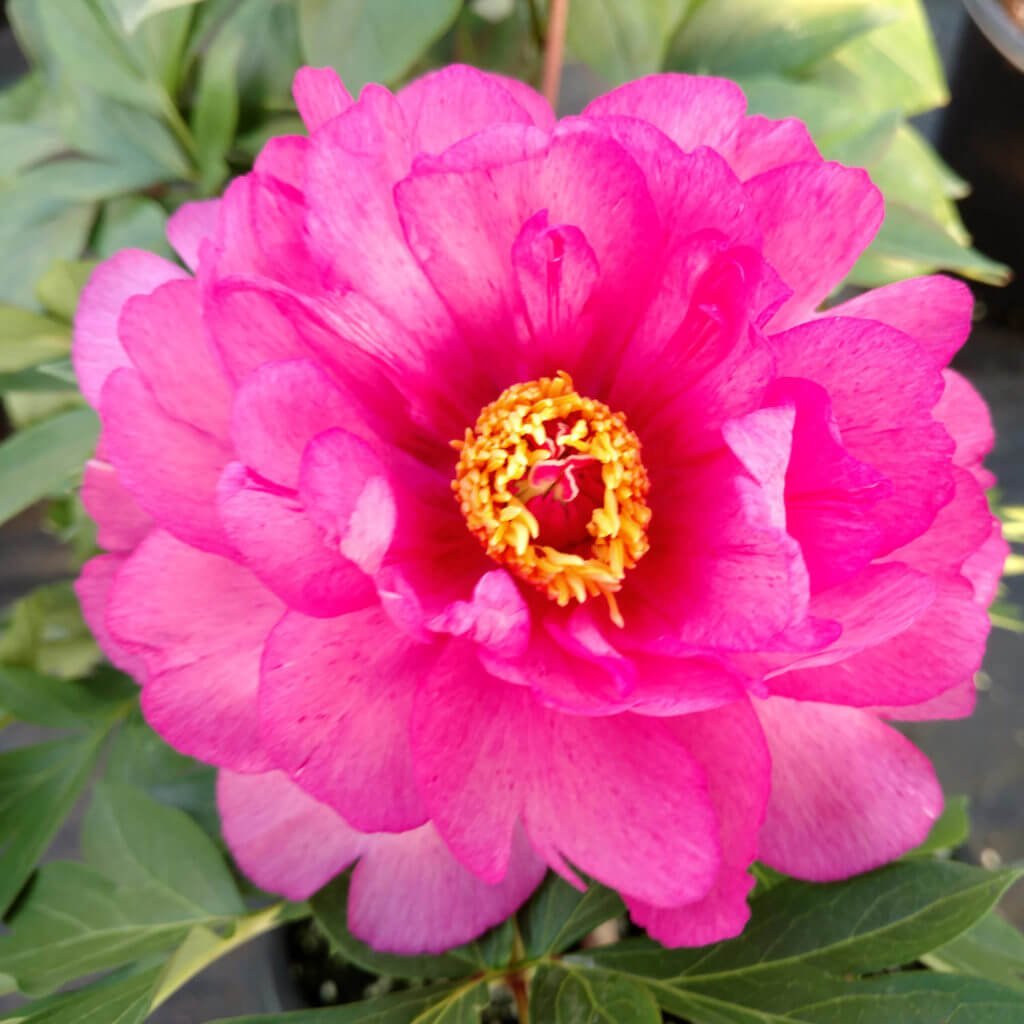
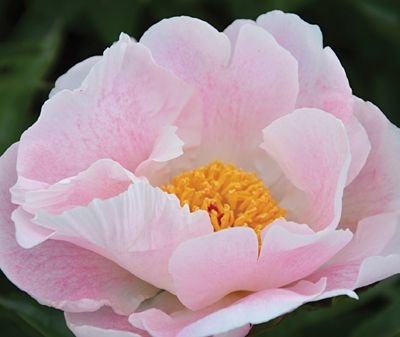
Intersectional (Itoh) Peonies
Intersectional peonies are hybrids between herbaceous and tree peonies, combining the best traits of both parents. These peonies feature sturdy stems, prolific blooming habits, and a wide range of colors and flower forms. Intersectional peonies are prized for their compact growth habit, long bloom period, and exceptional garden performance. Here are some common types of Intersectional peonies:
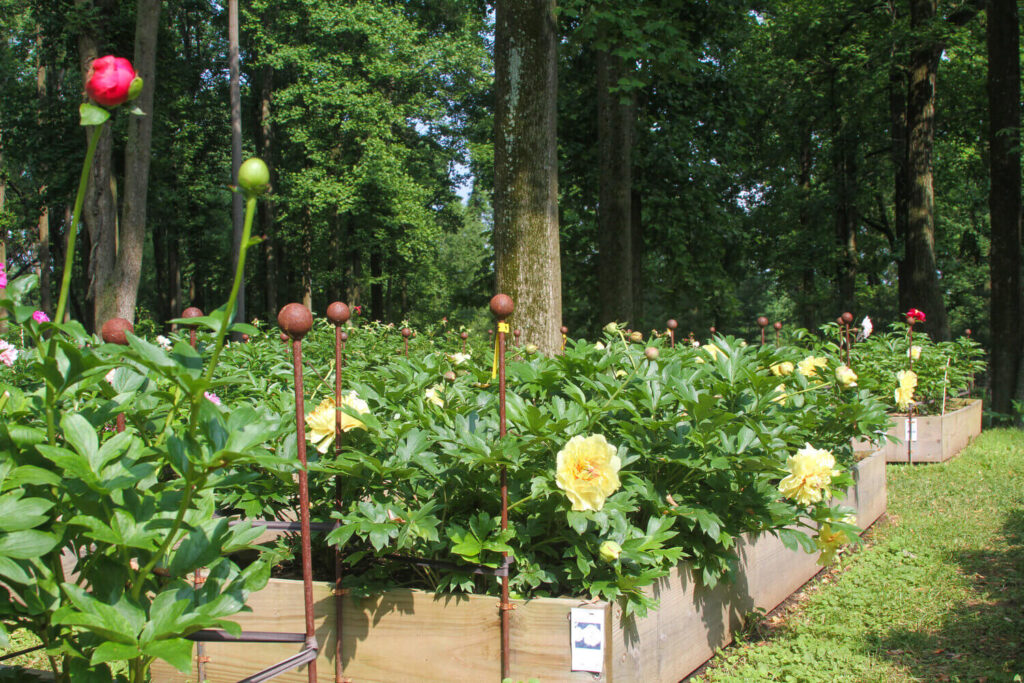
Single-flowered Intersectional Peonies
These varieties feature a single row of petals surrounding a central cluster of stamens. Single-flowered Intersectional peonies often have large, showy blooms with a simple yet elegant appearance. Examples include ‘Cora Louise’, ‘Julia Rose’, and ‘Border Charm’.
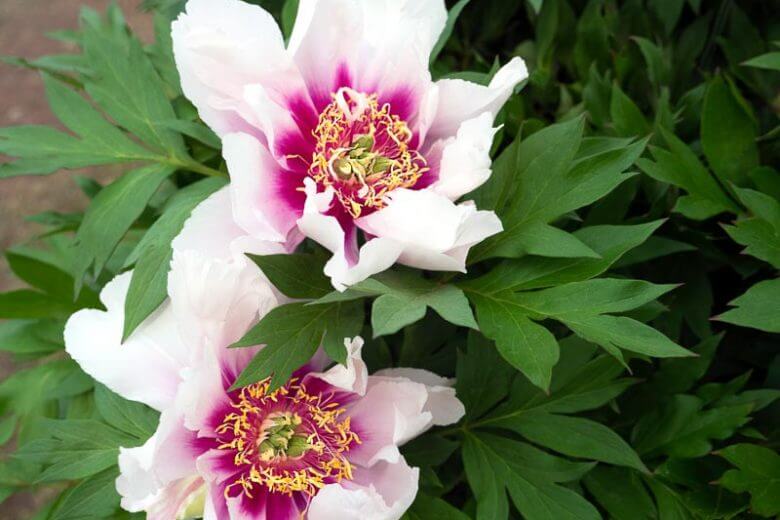
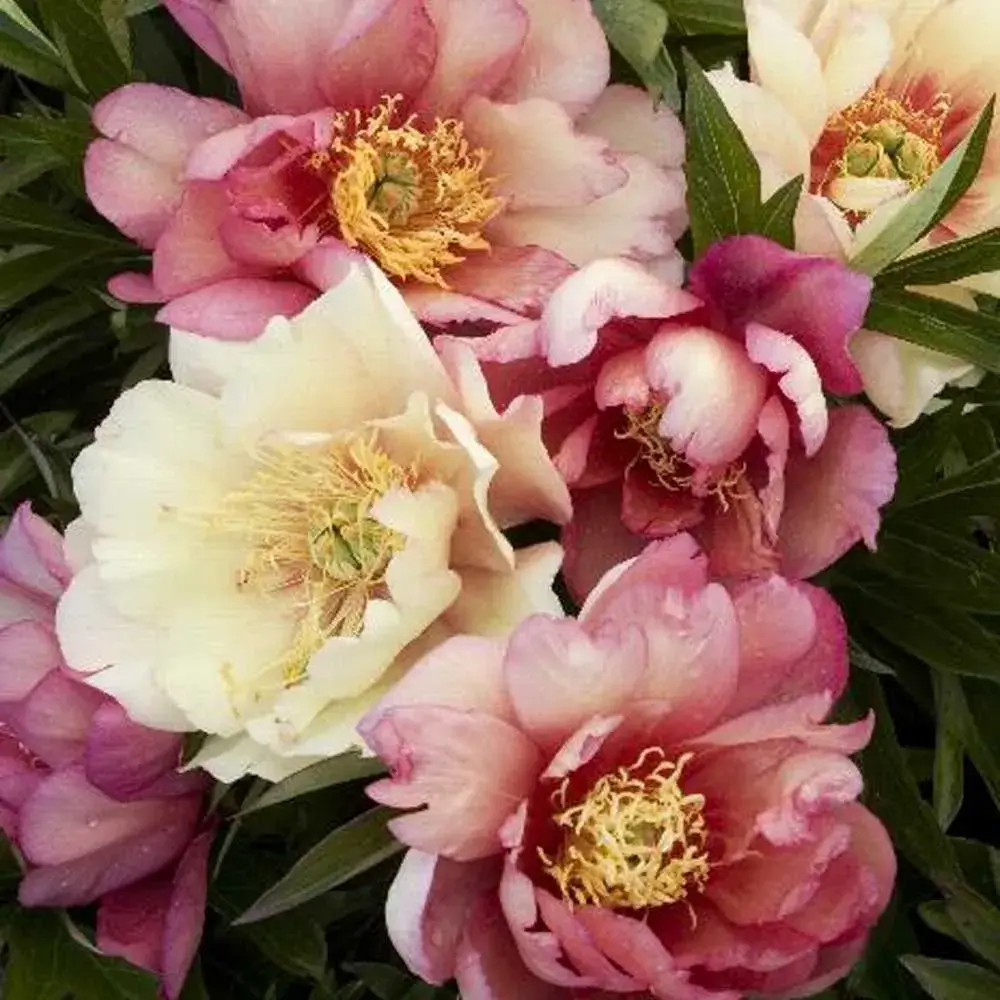
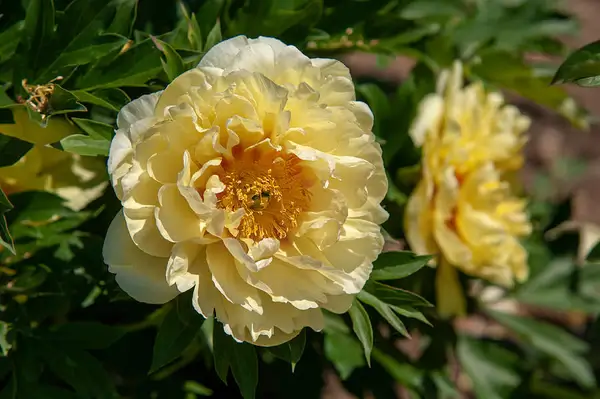
Double-flowered Intersectional Peonies
Double-flowered Intersectional peonies are prized for their densely packed petals, creating a lush and opulent bloom. These peonies may have multiple layers of petals, giving them a lavish and voluminous appearance. Varieties such as ‘Bartzella’, ‘Callie’s Memory’, and ‘Copper Kettle’ showcase the beauty of double-flowered Intersectional peonies.
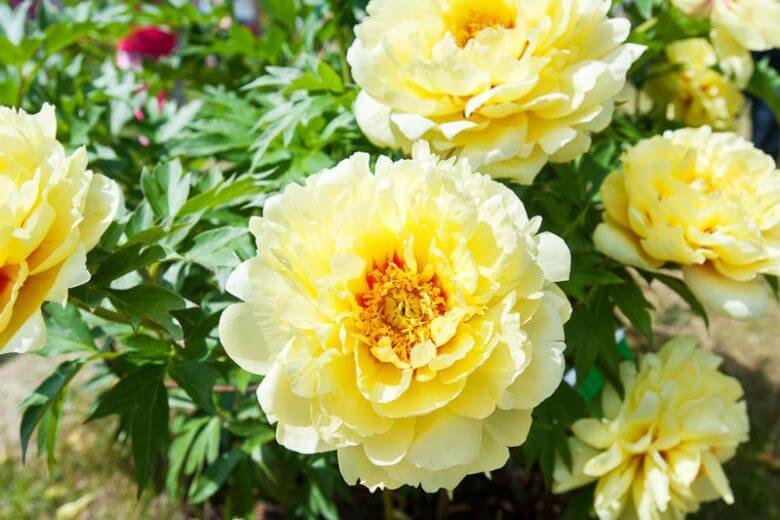
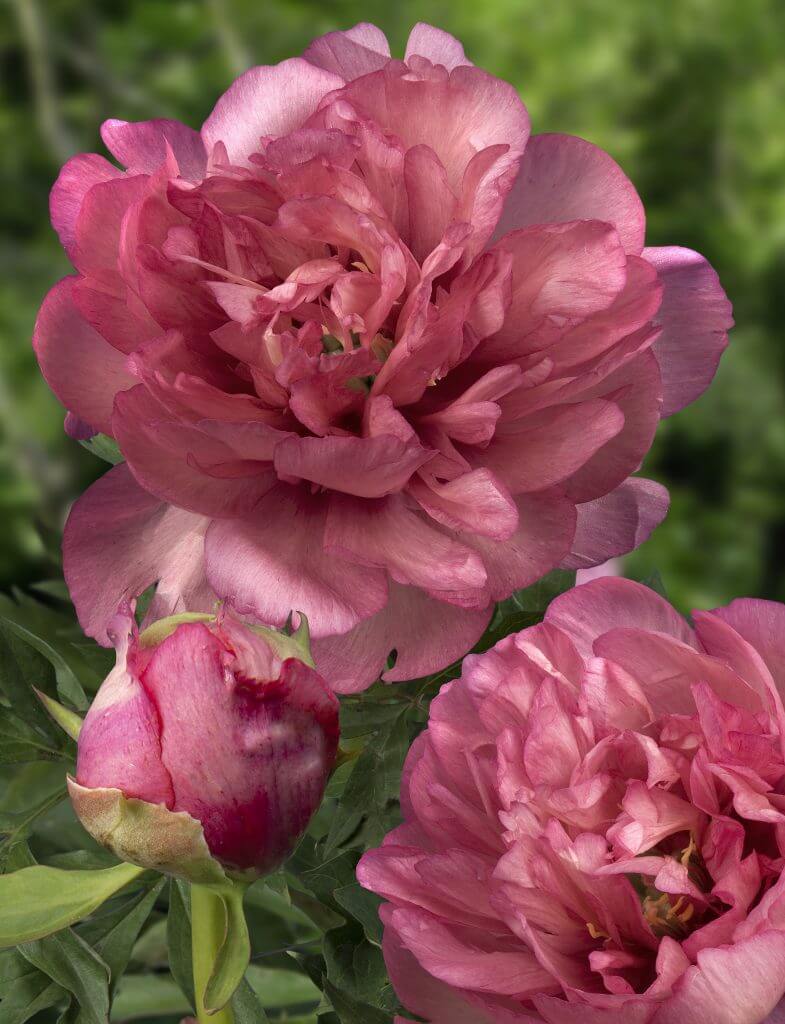
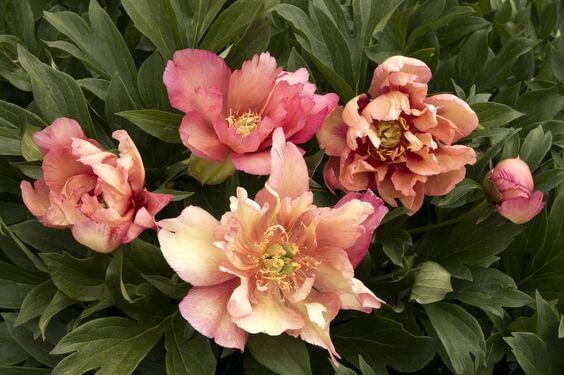
Semi-double-flowered Intersectional Peonies
Semi-double-flowered Intersectional peonies feature a combination of petals and stamens, offering a more intricate bloom form than singles. These peonies strike a balance between the simplicity of single-flowered varieties and the lushness of doubles. Varieties like ‘Canary Brilliants’, ‘Garden Treasure’, and ‘Hillary’ exemplify the charm of semi-double-flowered Intersectional peonies.
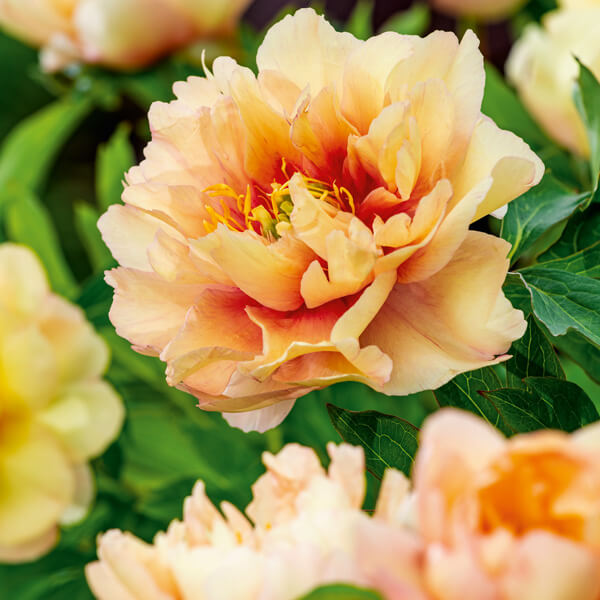
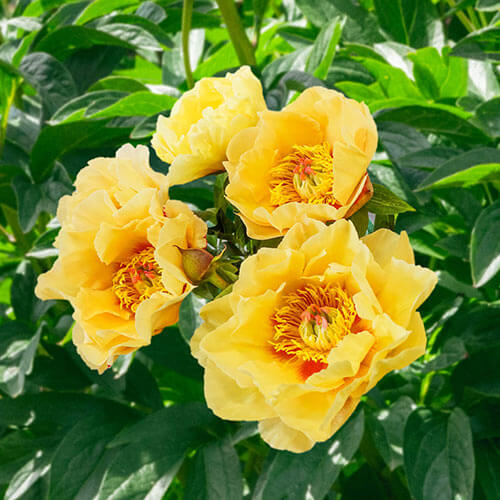
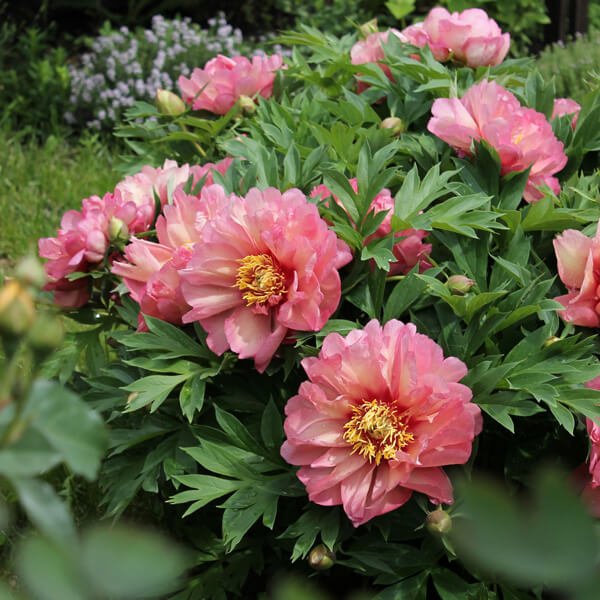
Japanese-flowered Intersectional Peonies
Japanese-flowered Intersectional peonies feature a center of petaloid stamens surrounded by one or more rows of broad, flat petals. The central stamens may be of a contrasting color, creating a striking contrast with the surrounding petals. Varieties such as ‘Sequestered Sunshine’ showcase the beauty of Japanese-flowered Intersectional peonies.
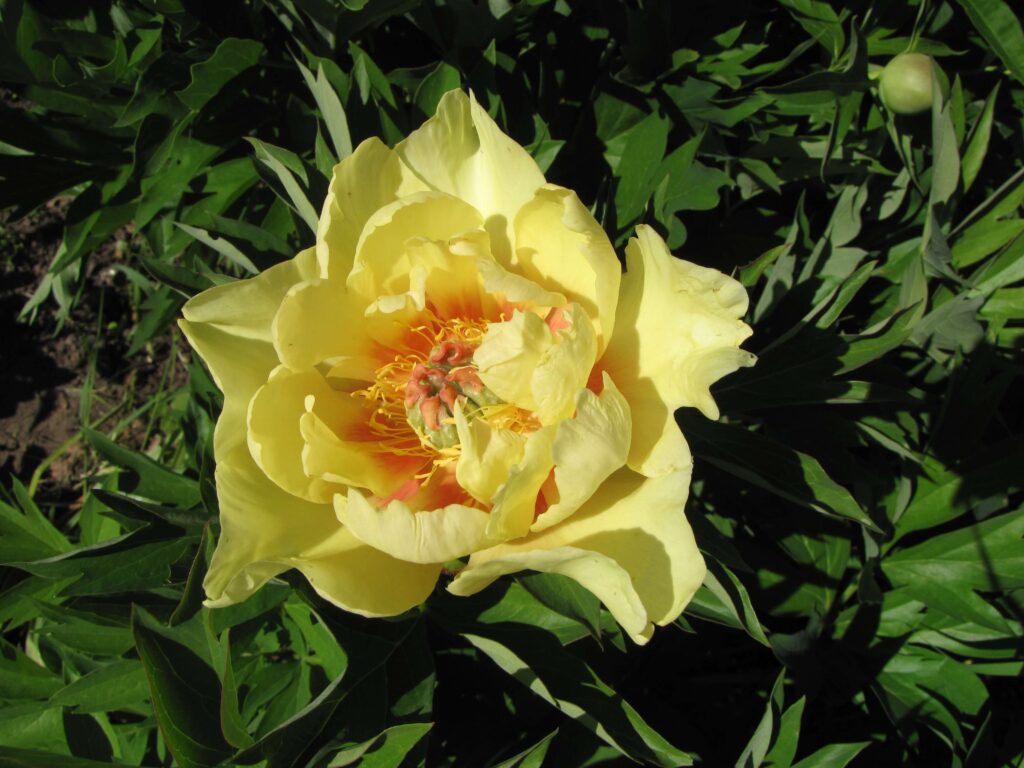
Unique Hybrid Intersectional Peonies
Intersectional peonies are hybrids with diverse colors, forms, and characteristics resulting from crosses between species or varieties. These peonies often exhibit unique traits and may incorporate traits from both parents. Examples include ‘Morning Lilac’, ‘Yellow Doodle Dandy’, and ‘Lemon Chiffon’.
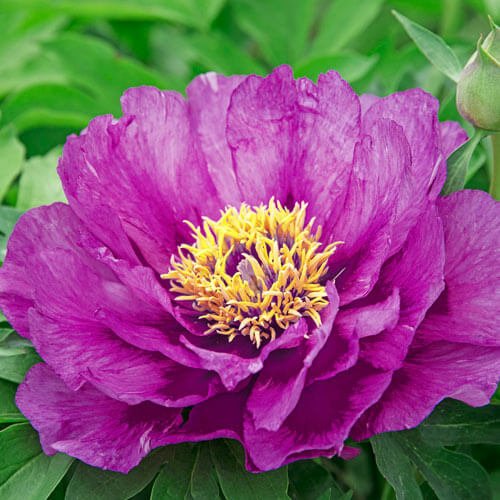
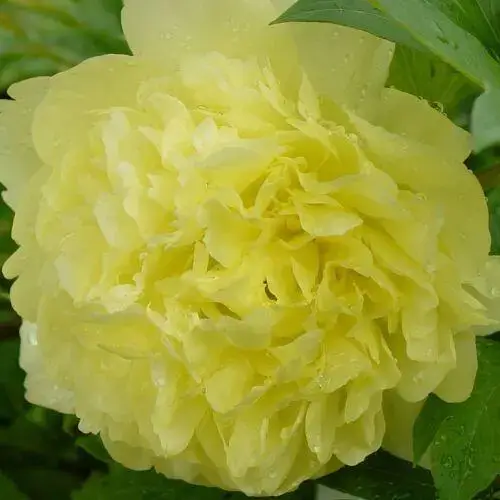
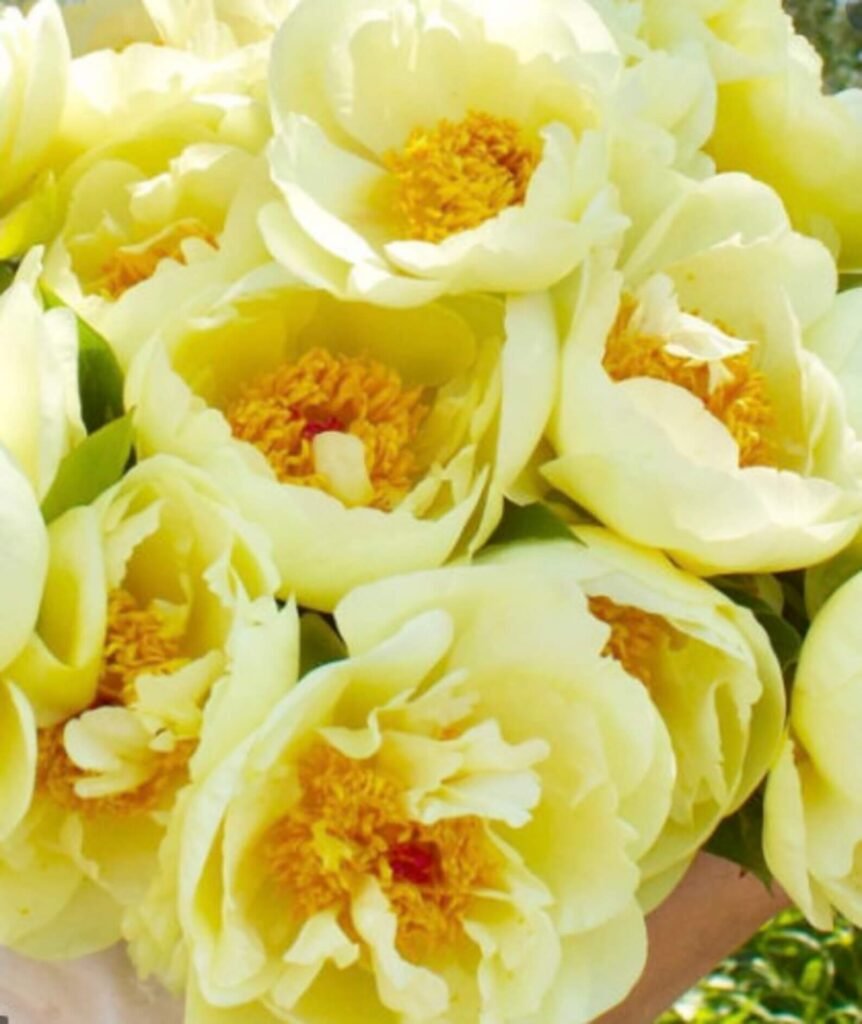
Creating the Ideal Growing Conditions
How to grow peonies requires planting them in well-draining soil with good sunlight exposure. They need well-draining soil with a pH of 6.5-7.5, 6 hours of sunlight daily, and balanced fertilizer in spring. Mulch with organic materials to retain moisture and regulate soil temperature.
Sunlight and Soil Requirements
For peonies, choose a well-drained, sunny area with loamy, slightly acidic soil enriched with organic matter. To check drainage, fill a hole with water and see if it drains within a few hours. Give peonies space away from competing trees or shrubs.
Optimizing Watering and Fertilization
Proper soil preparation is essential in learning how to grow peonies successfully. To ensure the optimal growth and blooming of your peonies, it’s essential to follow a few key care practices. Water deeply once a week during dry spells. Apply low-nitrogen fertilizer in early spring. Spread organic mulch around plants to retain moisture and suppress weeds. Use slow-release fertilizer for consistent nutrition. These practices will contribute to the overall health and vitality of your peonies, supporting their growth and abundant flowering.
Planting and Transplanting Techniques
When planting peonies, it’s essential to select a location with well-draining soil and abundant sunlight to support their healthy growth. Add organic matter to soil and dig wide holes for peony roots. When transplanting, excavate as much of the root ball as possible and reposition at the same depth.
Preparing the Soil for Planting
Before planting peonies, it’s crucial to ensure that the soil is well-prepared to provide an ideal environment for their growth. Loosen the soil to 12 inches using a fork or tiller. Add balanced fertilizer as per package instructions to enrich the soil with nutrients. Remove weeds and debris to prevent competition for resources and pest infestations. Test soil pH and adjust it to the optimal range of 6.5 to 7.0 for successful peony cultivation.
Transplanting Peonies with Care
When transplanting peonies, it’s crucial to prepare them adequately for the move. Begin by watering the peonies thoroughly a day or two before digging them up to ensure they are well-hydrated for the transplantation process. Using a sharp shovel or spade, carefully dig around the plant, creating a wide circle to minimize damage to the roots during transplantation. Once the peonies have been successfully transplanted, water them generously and apply a layer of mulch around the base to retain moisture and regulate soil temperature, aiding in their adjustment to the new environment. It’s important to refrain from fertilizing newly transplanted peonies immediately; instead, wait until they show new growth in their new location before applying any fertilizer to facilitate a smooth transition and encourage healthy development.
Caring for Peonies Throughout the Seasons
To keep your peonies thriving, regular watering is crucial, especially during hot and dry periods. This will maintain consistently moist soil without risking waterlogging, providing the ideal conditions for healthy growth. Applying a balanced fertilizer in early spring and after blooming will also support abundant flowering, ensuring your peonies reach their full potential. Additionally, mulching around your peonies in late fall can insulate them from extreme temperatures and retain moisture in the soil throughout winter. Don’t forget to deadhead your peonies by cutting off spent blooms right after flowering to redirect their energy into developing stronger roots, further promoting their overall health and vitality.
Pruning and Deadheading Tips
In early spring, it’s essential to prune away any dead or diseased foliage to discourage the spread of potential diseases and support the overall health of your peonies. Once planted, mastering how to grow peonies involves providing consistent care and attention. After the first fall frost, cutting back the peony stems to ground level and clearing away debris around the plants is crucial to minimize overwintering pests. Regularly deadheading faded flowers not only maintains a tidy appearance but also prevents seed production, redirecting the plant’s energy towards root and crown development. Additionally, removing spent foliage after the first frost plays a key role in eliminating overwintering diseases and pests, effectively preparing your peonies for a healthy upcoming growing season.
Winter Protection Strategies
It’s important to take protective measures to ensure that your peony plants remain insulated and well-protected during the winter months. By gently placing a layer of mulch over the base of the plants in late fall, you can shield them from extreme temperature fluctuations, providing essential insulation. Utilizing protective coverings such as burlap or frost cloth can safeguard your peonies from harsh winds and heavy snow accumulation, minimizing the risk of damage. Additionally, avoid walking on frozen or snow-covered soil around peony beds to prevent compaction that could potentially harm delicate root systems during their winter dormancy. Applying a layer of straw or evergreen boughs over the plants can offer additional insulation against freezing temperatures and frost heaving, further ensuring their well-being throughout the winter season.
Dealing with Pests and Diseases
When it comes to identifying common peony pests, keeping a close eye on the leaves and stems for any signs of discoloration or distortion is essential. Additionally, inspecting the undersides of the leaves and the surrounding soil for visible pests like spider mites, aphids, and nematodes can help in early detection. Implementing natural pest control methods, such as introducing beneficial insects like ladybugs or lacewings to combat harmful pests, can contribute to maintaining a healthy peony environment. Furthermore, applying a neem oil solution stands as a gentle yet effective approach to deterring and controlling various pests, safeguarding the well-being of your beloved peony plants.
Identifying Common Peony Pests
Peonies, while stunning and resilient, are susceptible to a range of pests and diseases. Spider mites, known for causing webbing on plants, and powdery mildew, characterized by a white powdery substance on leaves, are common issues to watch out for. Additionally, keep an eye out for aphids, small pests that tend to gather on new growth areas, and nematodes, which can lead to wilting or stunted growth in the soil. Furthermore, the presence of botrytis blight, indicated by brown spots on peony petals, often stems from excessive moisture or poor air circulation. Identifying and addressing these potential problems promptly is crucial to maintaining the health and vibrancy of your peonies.
Implementing Natural Pest Control Methods
Encouraging natural predators such as ladybugs, lacewings, and predatory mites is an effective method for controlling aphids and other small pests in your peony garden. Additionally, integrating aromatic plants like marigolds or chrysanthemums around your peonies can naturally deter certain pests due to their strong scents. If you’re dealing with soft-bodied insects like aphids, a simple yet effective solution involves spraying a mixture of water and mild dish soap, which helps reduce their populations without harming beneficial insects. Furthermore, utilizing diatomaceous earth around your peonies serves as a protective barrier against crawling pests while remaining harmless to both humans and pets. These natural pest control methods can contribute to maintaining a thriving and pest-resistant peony paradise in your garden.
Harvesting and Enjoying Your Peony Blooms
To ensure the best vase life for your peony blooms, it’s essential to harvest them at the right stage. When the buds are soft to the touch and displaying color, but not fully open, it’s the perfect time to cut them. After harvesting, trim the stems at a 45-degree angle and remove any foliage that will be below the waterline in your vase to prevent bacterial growth. When placing the freshly cut peonies in a vase, opt for lukewarm water with flower food to ensure proper hydration and full blooming over the next few days. To prolong the beauty of your peony blooms indoors, remember to keep them away from direct sunlight and sources of heat. This careful approach will help you learn how to grow peonies and fully enjoy these stunning plants.
Tips for Cutting and Arranging Peony Flowers
When cultivating peonies, it’s best to select flowers with buds displaying some color but still partially closed, as this leads to longer-lasting arrangements. To maintain the freshness of your peony arrangements, adding floral preservative to the vase water and changing it every other day is crucial. For an aesthetically pleasing arrangement, consider creating a focal point using larger, more open blooms surrounded by smaller buds and foliage. Additionally, cutting peonies in the early morning or late evening can help preserve their freshness due to cooler temperatures, ensuring your arrangements stand out beautifully.
Extending the Lifespan of Cut Peony Blooms
To extend the lifespan and beauty of your cut peonies, it’s essential to implement some simple yet effective care practices. Re-cutting the stems at an angle every few days not only encourages better water absorption but also contributes to prolonging the vibrancy of your peony blooms. Additionally, placing your peony arrangements away from ripening fruits is crucial, as the ethylene gas emitted can accelerate wilting. With proper care and attention, you can learn how to grow vibrant blooms from your peonies year after year. Moreover, keeping your peonies in a cool environment, free from drafts and excessive heat, can slow down the blooming process and extend their beauty. Lastly, misting your cut peonies with water daily provides them with the extra hydration they need, helping maintain their freshness for a longer period.
Conclusion
In conclusion, learning how to grow peonies successfully involves a comprehensive understanding of peony varieties, creating ideal growing conditions, mastering planting and transplanting techniques, and providing continuous care throughout the seasons. It’s essential to prioritize sunlight, soil, watering, and fertilization for optimal growth. Additionally, implementing effective pest control methods and strategies to combat diseases is crucial for maintaining a thriving peony paradise. Furthermore, harvesting and enjoying peony blooms require careful attention to detail, from selecting the right stage for harvesting to arranging them in a vase with proper care practices that extend their lifespan. By following these guidelines, you can cultivate a stunning and vibrant peony garden that brings endless joy and beauty to your outdoor space.
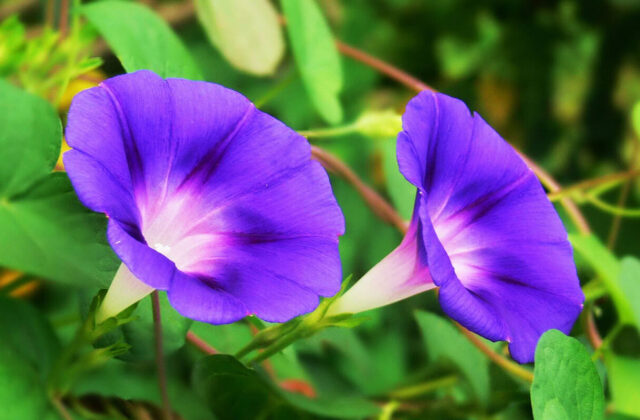
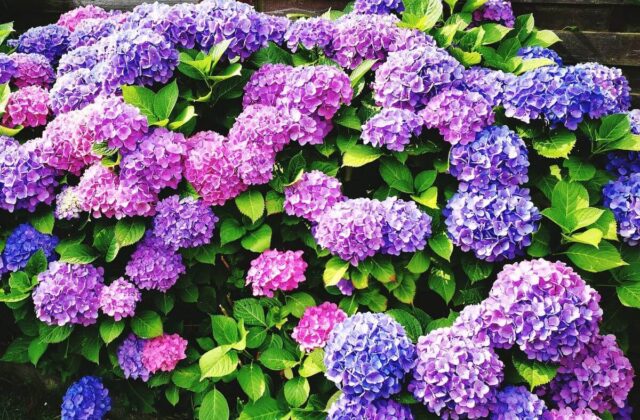
136 comments
Lots of people use their lotteries to raise money for useful initiatives that improve education, general public infrastructure and social services.
Once the lottery is performed by you, you’re helping to finance these programs when you fund your
own wishes of winning it big. Have fun and all the best!
Wow, awesome blog structure! How long have you been running a blog
for? you made running a blog glance easy. The whole look of
your website is wonderful, let alone the content! You can see similar:
najlepszy sklep and here najlepszy sklep
I just like the helpful information you provide for your articles.
I’ll bookmark your weblog and test again here frequently.
I am relatively certain I will be informed
plenty of new stuff proper right here! Best of luck for the next!
I saw similar here: sklep internetowy and
also here: sklep internetowy
Somebody essentially assist to make significantly posts
I would state. That is the very first time I frequented your web page and so far?
I surprised with the research you made to create this actual publish extraordinary.
Great job! I saw similar here: Dobry sklep
I’m excited to find this web site. I want to to thank you
for ones time for this particularly wonderful read!! I definitely liked every little bit of it and I have you book-marked
to check out new stuff on your blog. I saw similar here: Sklep
With havin so much written content do you ever run into any
problems of plagorism or copyright violation? My website has a lot of exclusive
content I’ve either authored myself or outsourced but it looks like a
lot of it is popping it up all over the internet without my permission.
Do you know any methods to help prevent content from
being stolen? I’d really appreciate it. I saw similar
here: Ecommerce
Good day! Do you know if they make any plugins to assist with SEO?
I’m trying to get my blog to rank for some targeted keywords but
I’m not seeing very good gains. If you know of any please share.
Cheers! You can read similar text here: Dobry sklep
Good day! Do you know if they make any plugins to help with SEO?
I’m trying to get my blog to rank for some targeted keywords but
I’m not seeing very good results. If you know of any please share.
Appreciate it! You can read similar text here: Sklep internetowy
Hey! Do you know if they make any plugins
to help with Search Engine Optimization? I’m trying to get my blog to rank
for some targeted keywords but I’m not seeing very good results.
If you know of any please share. Cheers! You can read similar art
here: Sklep internetowy
I’m now not positive the place you’re getting your info,
however great topic. I needs to spend a while learning much more or figuring out more.
Thank you for wonderful information I was on the lookout for this information for
my mission.
Feel free to visit my web-site :: vpn code 2024
Hello! Do you know if they make any plugins to assist with Search Engine Optimization? I’m
trying to get my website to rank for some targeted keywords
but I’m not seeing very good gains. If you know of any please share.
Many thanks! You can read similar blog here: Backlinks List
Hi! Do you know if they make any plugins to help with Search Engine Optimization? I’m trying
to get my website to rank for some targeted keywords
but I’m not seeing very good success. If you know of any please share.
Appreciate it! You can read similar article here: GSA Verified List
[url=https://oazithromycin.com/]zithromax coupon[/url]
[url=https://azithromycinmds.com/]buy azithromycin without a prescription[/url]
[url=http://bestmedsx.online/]reputable overseas online pharmacies[/url]
Wow, superb weblog format!
How long have you ever been blogging for? you made blogging glance easy.
The full look of your site is wonderful, let alone the content
material! I read similar here prev next and those was
wrote by Louann92.
Wow, superb blog format!
How lengthy have you been blogging for? you
make running a blog glance easy. The full glance of your web site is magnificent, as neatly as the content material!
You can read similar here prev next and those was wrote by
Dian84.
[url=http://metforminn.com/]metformin canada over the counter[/url]
Wow, amazing blog structure!
How lengthy have you ever been running a blog for?
you make running a blog look easy. The whole look of your web site is great, let alone the content material!
I read similar here prev next and that was wrote by Arleen04.
[url=http://drugstorepp.online/]canadian pharmacy sildenafil[/url]
[url=http://ezithromycin.online/]how much is zithromax 250 mg[/url]
[url=https://oazithromycin.online/]zithromax 600 mg tablets[/url]
[url=http://bestmedsx.online/]mexican pharmacy weight loss[/url]
batmanapollo.ru
[url=https://bestmedsx.online/]pharmacy order online[/url]
darkmarkets [url=https://mydarkmarket.com/ ]dark web market links [/url] deep web links
[url=https://oazithromycin.online/]cost of generic azithromycin[/url]
[url=http://drdoxycycline.online/]doxycycline cost australia[/url]
[url=https://ezithromycin.online/]azithromycin order online uk[/url]
[url=https://ciprocfx.com/]cipro 250 mg[/url]
online canadian pharmacy no prescription needed
pharmacy drugstore online
child porn
[url=http://baclofem.com/]where can i get baclofen[/url]
[url=http://azithromycinmds.com/]azithromycin over the counter price[/url]
порно
[url=https://diflucand.online/]generic diflucan 150 mg[/url]
[url=https://odiflucan.online/]diflucan 150 mg otc[/url]
us pharmacy no prior prescription
[url=https://baclofem.com/]baclofen over the counter canada[/url]
[url=https://ibaclofen.com/]baclofen tab 10mg[/url]
[url=http://doxycyclineo.com/]doxycycline 40 mg capsules[/url]
[url=http://tadalafilu.com/]cialis pills for sale uk[/url]
[url=http://flomaxms.online/]buy flomax uk[/url]
[url=https://okmodafinil.com/]buy modafinil online us[/url]
[url=https://albuterolo.com/]purchase ventolin inhaler online[/url]
canadianpharmacynoprescription.net
[url=https://modafinilmip.online/]how to buy modafinil australia[/url]
[url=http://lasixtbs.online/]buy furosemide 40 mg online uk[/url]
[url=https://modafinile.com/]how to buy modafinil online[/url]
[url=http://eflomax.com/]flomax for kidney stones in females[/url]
[url=https://ibaclofen.online/]baclofen 10mg tablets[/url]
[url=https://advaird.online/]advair 500 50[/url]
[url=http://mcadvair.online/]advair 500 mg[/url]
canadian pharmacy direct
[url=https://ibaclofen.com/]lioresal best price[/url]
[url=https://acyclovirmc.com/]acyclovir 800 mg price in india[/url]
[url=https://doxycyclineo.com/]doxycycline 7.5 mg[/url]
androgel canadian pharmacy
[url=https://doxycyclineo.online/]doxycycline 100mg tabs[/url]
[url=https://odiflucan.com/]diflucan 200 mg capsule[/url]
[url=https://mcadvair.online/]best advair prices[/url]
[url=http://baclofenx.com/]baclofen 25 mg[/url]
[url=http://vermox.company/]vermox tablet price in india[/url]
[url=http://adexamethasonep.online/]dexona 4mg[/url]
[url=http://diflucand.online/]diflucan 500 mg[/url]
[url=https://baclofem.com/]baclofen 10 mg buy online[/url]
[url=http://ifinasteride.com/]finasterid[/url]
[url=http://effexor.directory/]effexor 75 price[/url]
[url=https://effexor.directory/]effexor cost canada[/url]
[url=http://glucophage.online/]metformin cost in india[/url]
[url=https://eflomax.online/]flomax australia[/url]
[url=https://vermoxin.online/]online pharmacy vermox[/url]
[url=http://doxycyclineo.com/]doxycline[/url]
[url=http://aaccutane.com/]accutane mexico[/url]
[url=https://ciprocfx.com/]buy ciprofloxacin 500mg uk[/url]
[url=http://dexamethasonen.com/]dexamethasone 5[/url]
[url=http://diflucand.online/]buy diflucan over the counter[/url]
[url=https://xlyrica.online/]lyrica 50 mg tablets[/url]
[url=https://advaird.online/]advair 500[/url]
[url=https://strattera.company/]strattera online[/url]
[url=https://okmodafinil.com/]can you buy modafinil[/url]
[url=https://dezithromax.online/]buy zithromax pills[/url]
[url=https://lasixtbs.online/]lasix online pharmacy[/url]
[url=https://tretinoineff.online/]tretinoin gel prescription online[/url]
[url=http://mcadvair.online/]generic for advair diskus[/url]
[url=https://dexamethasonen.com/]dexamethasone 4[/url]
[url=http://dezithromax.online/]can you purchase zithromax[/url]
[url=http://bacclofen.online/]lioresal 5 mg[/url]
[url=http://toradol.directory/]toradol allergy[/url]
[url=http://bacclofen.online/]baclofen 159[/url]
[url=http://avermox.online/]vermox 100mg price[/url]
[url=https://eflomax.com/]how much is flomax[/url]
[url=http://xmodafinil.com/]provigil uk prescription[/url]
Very interesting topic, regards for putting up. “Nothing great was ever achieved without enthusiasm.” by George Ellis.
[url=https://ifinasteride.com/]finasteride 1mg coupon[/url]
[url=https://odiflucan.online/]candida diflucan[/url]
[url=https://tadalafilu.com/]tadalafil soft tabs cheap[/url]
[url=http://lasixtbs.com/]lasix canada no prescription[/url]
[url=https://lasixor.com/]order lasix without a prescription[/url]
[url=https://flomaxms.com/]flomax generic for sale[/url]
[url=https://declomid.online/]clomid medication in mexico[/url]
[url=https://doxycyclineo.online/]doxycycline canadian pharmacy[/url]
[url=http://flomaxms.com/]buy noroxin[/url]
[url=http://acyclovirlp.online/]cheap zovirax cream online[/url]
[url=https://avermox.online/]vermox plus[/url]
[url=https://modafinilmip.online/]modafinil 100 mg tablet[/url]
[url=https://acyclovirmc.com/]buy valacyclovir without a prescription[/url]
[url=https://ciproffl.online/]ciprofloxacin order online[/url]
[url=https://doxycyclineo.com/]buy cheap doxycycline uk[/url]
[url=https://lasixav.online/]can you buy furosemide over the counter[/url]
[url=https://accutaneo.com/]buy accutane 10mg online[/url]
[url=https://ciprocfx.com/]order ciprofloxacin online[/url]
[url=http://iclomid.com/]where to buy clomid australia[/url]
[url=https://doxycyclineo.online/]purchase doxycycline online uk[/url]
[url=http://nolvadexin.online/]buy nolvadex in india[/url]
[url=https://lasixtbs.online/]lasix tablets for sale[/url]
Wait a minute? Why is it only showing my views? :O
[url=http://diflucand.online/]diflucan buy[/url]
[url=https://doxycyclineo.online/]order doxycycline no prescription[/url]
[url=https://albuterolo.com/]can i buy albuterol[/url]
I like assembling useful information , this post has got me even more info!
[url=https://declomid.online/]clomid for sale in mexico[/url]
[url=http://eflomax.online/]flomax online prescription[/url]
[url=https://advaird.com/]advair cost in canada[/url]
[url=http://lasixav.online/]furosemide pills[/url]
[url=https://xmodafinil.com/]order modafinil[/url]
[url=https://tadacip.store/]tadacip 20 india[/url]
[url=https://mcadvair.online/]advair diskus 10 coupon[/url]
[url=http://xlyrica.com/]where to buy lyrica[/url]
[url=https://finasterideff.online/]best propecia[/url]
[url=https://glucophage.online/]where to get metformin in canada[/url]
[url=http://baclofem.com/]baclofen generic price in india[/url]
Can you be more specific about the content of your article? After reading it, I still have some doubts. Hope you can help me.
[url=https://avermox.online/]vermox buy[/url]
[url=https://accutaneiso.online/]accutane uk[/url]